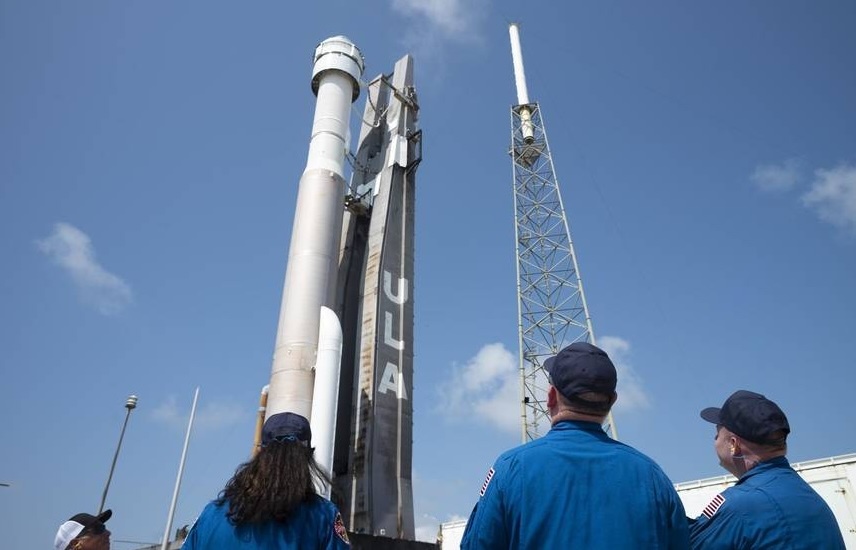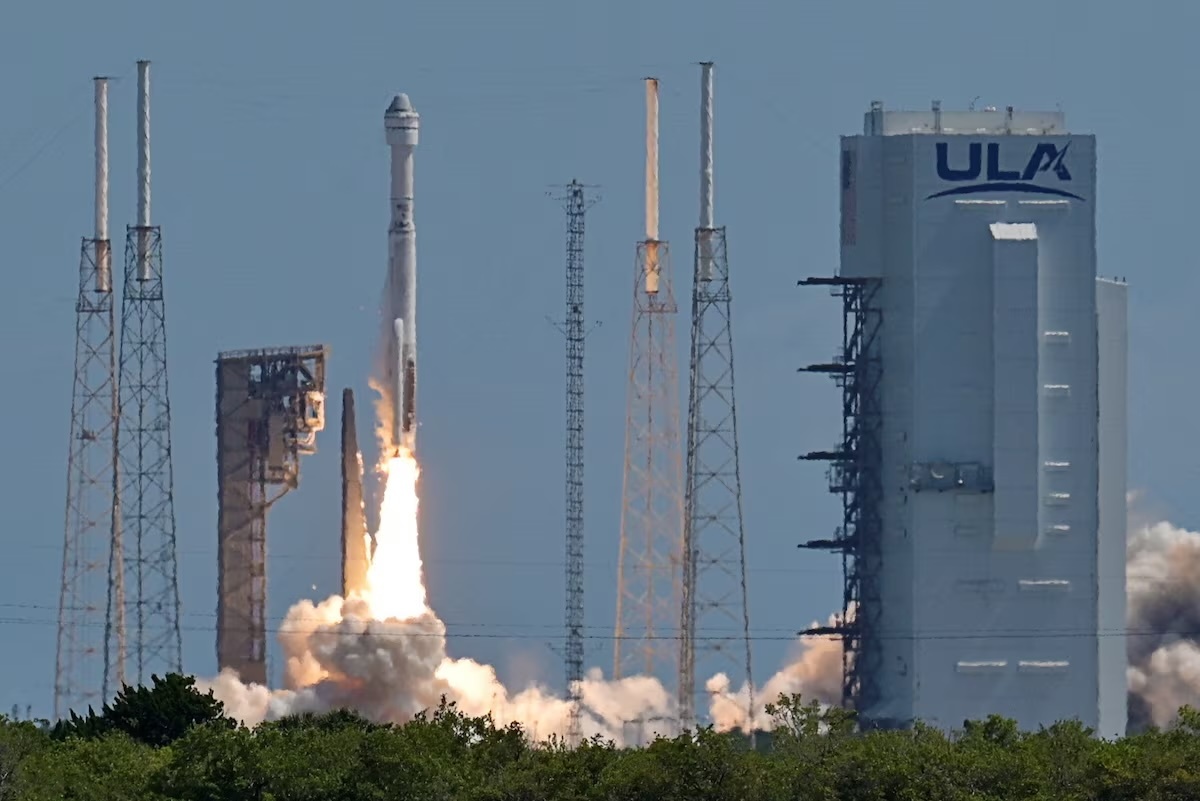It's unclear when Starliner will fly again, and whether or not that mission will carry astronauts.
More than six months after its first crewed mission came to a disappointing end, the future is still murky for Boeing's Starliner astronaut capsule.
That mission, called Crew Flight Test (CFT), launched on June 5, sending NASA astronauts Butch Wilmore and Suni Williams to the International Space Station(ISS) for a roughly 10-day stay. Starliner made it to the orbiting lab safely, but it experienced propulsion-system helium leaks and thruster failures along the way, and NASA extended CFT repeatedly to study the issues.
Finally, on Aug. 24, the agency decided to bring Starliner home uncrewed, which occurred without incident on Sept. 6 in the New Mexico desert. Williams and Wilmore were reassigned to a long-duration ISS mission, which wrapped up yesterday (March 18) with the splashdown of SpaceX's Crew Dragon capsule "Freedom."
The dolphin-attended splashdown marked the end of Crew-9, SpaceX's ninth operational, long-duration astronaut mission to the ISS for NASA. (Crew-9 launched in late September with two instead of the usual four crewmembers on board, to save seats for Williams and Wilmore on the way back to Earth.)
SpaceX's Crew-10 arrived at the ISS on Sunday (March 16) to relieve the Crew-9 astronauts, and Crew-11 is scheduled to launch this summer, perhaps as early as July. Elon Musk's company may even send Crew-12 skyward before Starliner carries astronauts again, because NASA and Boeing are still mapping out the new capsule's next steps.
"We're certainly looking at Starliner very carefully," Steve Stich, manager of NASA's Commercial Crew Program, said on Tuesday during a press conference after Crew-9's splashdown.
"We're in the process of looking at that vehicle, looking at the helium system," he added. "We've got some candidate seals that we're going to replace. We'll get into some testing here over the summer timeframe with what we call an 'integrated doghouse' at White Sands [a NASA test facility in New Mexico]."
"Doghouse" is the term NASA and Boeing use for the thruster pods on Starliner's service module. The module sports four such pods, each of which houses 12 thrusters — five of the relatively powerful "orbital maneuvering and control" (OMAC) class and seven "reaction control system" (RCS) thrusters, which are used for finer adjustments, such as those needed during docking.
The thruster problems Starliner experienced during CFT concerned the RCS hardware: Five of the 28 RCS thrusters conked out during Starliner's approach to the ISS, though the mission team eventually brought four of the five affected ones back online.
Ground testing has linked the RCS thruster issue to overheating: Repeated thruster firings can apparently warm up the doghouses so much that some of their Teflon seals bulge, affecting propellant flow.
This theory is informing adjustments to Starliner's design and operations going forward, according to Stich.
"I think we have some changes we need to make to the way we heat those thrusters, the way we fire those thrusters, and then we can test that on the next flight," he said.
Indeed, testing will be a big part of the next Starliner flight, whenever it lifts off.
"We need to make sure we can eliminate the helium leaks; eliminate the service module thruster issues that we had on docking," Stich said.
NASA has not yet decided whether the coming Starliner flight will carry astronauts or not, he added. But even if the mission is uncrewed, the agency wants it to be crew-capable — "to have all the systems in place that we could fly a crew with," Stich said.
"As I think about it, it might be there for a contingency situation, as we prepare for whatever events could happen," he added. "One of the things that I've learned in my time at NASA is, always be prepared for the unexpected."
NASA plans to certify Starliner for operational, long-duration astronaut missions shortly after this next flight, if all goes well.
"We really need to get Boeing into a crewed rotation," Stich said. "Butch and Suni's return on Dragon, to me, shows how important it is to have two different crew transportation systems, the importance of Starliner and the redundancy that we're building into human spaceflight for our low Earth orbit economy."
Quelle: SC
----
Update: 29.03.2025
.
NASA, Boeing Prepare for Starliner Testing

NASA and Boeing are making progress toward crew certification of the company’s CST-100 Starliner system following the Crew Flight Test to the International Space Station. Joint teams are working to resolve Starliner’s in-flight anomalies and preparing for propulsion system testing in the months ahead as NASA plans for Starliner’s next flight.
“NASA’s strategy for crew transportation is critical for assured access to space using American private industry,” said Ken Bowersox, associate administrator for Space Operations at NASA Headquarters in Washington. “Our investment in commercial crew transportation capabilities is providing the needed flexibility to operate in space as safely as possible and respond to changes quickly when they arise. NASA is seeing the commitment from Boeing to adding the Starliner system to the nation’s crew transportation base.”
In the months following the safe return of the uncrewed Starliner capsule from the International Space Station, NASA and Boeing have worked on postflight data analysis from its crewed flight test. There has been a significant amount of work completed, with more than 70% of flight observations and in-flight anomalies being closed at program-level control boards. The major in-flight propulsion system anomalies Starliner experienced in orbit are expected to remain open further into 2025, pending the outcome of various ground test campaigns and potential system upgrades.
NASA and Boeing are working to finalize the scope and timelines for various propulsion system test campaigns and analysis that is targeted throughout the spring and summer. Testing at White Sands Test Facility in New Mexico will include integrated firing of key Starliner thrusters within a single service module doghouse to validate detailed thermal models and inform potential propulsion and spacecraft thermal protection system upgrades, as well as operational solutions for future flights. These solutions include adding thermal barriers within the doghouse to better regulate temperatures and changing the thruster pulse profiles in flight to prevent overheating. Meanwhile, teams are continuing testing of new helium system seal options to mitigate the risk of future leaks.
“Once we get through these planned test campaigns, we will have a better idea of when we can go fly the next Boeing flight,” said Steve Stich, manager, NASA’s Commercial Crew Program at the agency’s Kennedy Space Center in Florida. “We’ll continue to work through certification toward the end of this year and then go figure out where Starliner fits best in the schedule for the International Space Station and its crew and cargo missions. It is likely to be in the timeframe of late this calendar year or early next year for the next Starliner flight.”
Mission managers are planning for the next Starliner flight to be a crew capable post-certification mission, and NASA also has the capability of flying only cargo depending on the needs of the agency.
The goal of NASA’s Commercial Crew Program is the development of two dissimilar human spaceflight systems to ensure crew safety and to meet the International Space Station’s need for continuous human presence aboard the space station.
Quelle: NASA
+++
Boeing's next Starliner launch for NASA could slip to early 2026 after fixes
"It is likely to be in the timeframe of late this calendar year or early next year for the next Starliner flight."
Boeing's Starliner capsule will remain ground-bound for a while longer yet.
Last June, Starliner launched on its first-ever crewed flight, which sent NASA astronauts Butch Wilmore and Suni Williams to the International Space Station(ISS) for a roughly weeklong stay.
That timeline soon changed, however, because Starliner suffered a few issues on its way to the orbiting lab — namely, helium leaks in its propulsion system and the failure of five of its 28 reaction control system (RCS) thrusters, which Starliner uses for fine adjustments such as the ones required during docking.
NASA extended Starliner's ISS stay multiple times to study the problems before deciding to bring the spacecraft back to Earth uncrewed, which happened in early September. Wilmore and Williams, meanwhile, were retasked to become long-term ISS crewmembers, staying aloft until March 18, when they returned to Earth with SpaceX's Crew-9 astronauts.
NASA and Boeing have made considerable progress in their analyses of data from Starliner's first crewed flight. For example, the mission team managed to bring four of the five failed RCS thrusters back online while Starliner was in orbit. And they later tied the issue to overheating in the capsule's engine pods, which likely restricted propellant flow.
However, technicians are still working on fixes for the thruster and helium-leak issues and will likely continue to do so for several more months, NASA officials said in an update on Thursday (March 27).
That work will include test-firings of Starliner RCS thrusters at NASA's White Sands Test Facility in New Mexico "to validate detailed thermal models and inform potential propulsion and spacecraft thermal protection system upgrades, as well as operational solutions for future flights," NASA officials wrote in an update on Thursday afternoon (March 27).
Teams will also continue to test new seal options for the helium system, in an effort to minimize the risks of leaks going forward.
“Once we get through these planned test campaigns, we will have a better idea of when we can go fly the next Boeing flight,” Steve Stich, manager of NASA’s Commercial Crew Program at Kennedy Space Center in Florida, said in the Thursday statement.
"We’ll continue to work through certification toward the end of this year and then go figure out where Starliner fits best in the schedule for the International Space Station and its crew and cargo missions," he added. "It is likely to be in the timeframe of late this calendar year or early next year for the next Starliner flight."
"Certification" refers to giving Starliner the green light to fly astronauts on long-duration, contracted missions to and from the ISS for NASA. But the agency still doesn't know if the next flight for the Boeing capsule will be crewed or not.
"Mission managers are planning for the next Starliner flight to be a crew capable post-certification mission, and NASA also has the capability of flying only cargo depending on the needs of the agency," NASA officials wrote in Thursday's statement.
NASA also holds a commercial crew contract with SpaceX. Elon Musk's company launched its 10th operational astronaut mission to the orbiting lab under this deal on March 14.
Quelle: SC


